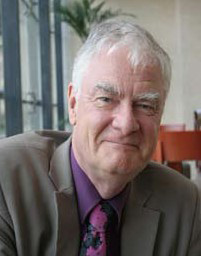The ellipsis..., also known informally as dot dot dot, is a series of dots that indicates an intentional omission of a word, sentence, or whole section from a text without altering its original meaning. The word originates from the Ancient Greek: ἔλλειψις, élleipsis meaning 'leave out'.

Systemic functional grammar (SFG) is a form of grammatical description originated by Michael Halliday. It is part of a social semiotic approach to language called systemic functional linguistics. In these two terms, systemic refers to the view of language as "a network of systems, or interrelated sets of options for making meaning"; functional refers to Halliday's view that language is as it is because of what it has evolved to do. Thus, what he refers to as the multidimensional architecture of language "reflects the multidimensional nature of human experience and interpersonal relations."

In linguistics, deixis is the use of general words and phrases to refer to a specific time, place, or person in context, e.g., the words tomorrow, there, and they. Words are deictic if their semantic meaning is fixed but their denoted meaning varies depending on time and/or place. Words or phrases that require contextual information to be fully understood—for example, English pronouns—are deictic. Deixis is closely related to anaphora. Although this article deals primarily with deixis in spoken language, the concept is sometimes applied to written language, gestures, and communication media as well. In linguistic anthropology, deixis is treated as a particular subclass of the more general semiotic phenomenon of indexicality, a sign "pointing to" some aspect of its context of occurrence.

A figure of speech or rhetorical figure is a word or phrase that intentionally deviates from ordinary language use in order to produce a rhetorical effect. Figures of speech are traditionally classified into schemes, which vary the ordinary sequence of words, and tropes, where words carry a meaning other than what they ordinarily signify.

In corpus linguistics, a collocation is a series of words or terms that co-occur more often than would be expected by chance. In phraseology, a collocation is a type of compositional phraseme, meaning that it can be understood from the words that make it up. This contrasts with an idiom, where the meaning of the whole cannot be inferred from its parts, and may be completely unrelated.
In linguistics, anaphora is the use of an expression whose interpretation depends upon another expression in context. In a narrower sense, anaphora is the use of an expression that depends specifically upon an antecedent expression and thus is contrasted with cataphora, which is the use of an expression that depends upon a postcedent expression. The anaphoric (referring) term is called an anaphor. For example, in the sentence Sally arrived, but nobody saw her, the pronoun her is an anaphor, referring back to the antecedent Sally. In the sentence Before her arrival, nobody saw Sally, the pronoun her refers forward to the postcedent Sally, so her is now a cataphor. Usually, an anaphoric expression is a proform or some other kind of deictic (contextually-dependent) expression. Both anaphora and cataphora are species of endophora, referring to something mentioned elsewhere in a dialog or text.
In sociolinguistics, a register is a variety of language used for a particular purpose or in a particular communicative situation. For example, when speaking officially or in a public setting, an English speaker may be more likely to follow prescriptive norms for formal usage than in a casual setting, for example, by pronouncing words ending in -ing with a velar nasal instead of an alveolar nasal, choosing words that are considered more "formal", and refraining from using words considered nonstandard, such as ain't and y'all.
In grammar, parallelism, also known as parallel structure or parallel construction, is a balance within one or more sentences of similar phrases or clauses that have the same grammatical structure. The application of parallelism affects readability and may make texts easier to process.
In pragmatics, exophora is reference to something extratextual, i.e. not in the immediate text, and contrasts with endophora. Exophora can be deictic, in which special words or grammatical markings are used to make reference to something in the context of the utterance or speaker. For example, pronouns are often exophoric, with words such as "this", "that", "here", "there", as in that chair over there is John's said while indicating the direction of the chair referred to. Given "Did the gardener water those plants?", it is quite possible that "those" refers back to the preceding text, to some earlier mention of those particular plants in the discussion. But it is also possible that it refers to the environment in which the dialogue is taking place—to the "context of situation", as it is called—where the plants in question are present and can be pointed to if necessary. The interpretation would be "those plants there, in front of us". This kind of reference is called exophora, since it takes us outside the text altogether. Exophoric reference is not cohesive, since it does not bind the two elements together into a text.
In linguistics, coreference, sometimes written co-reference, occurs when two or more expressions refer to the same person or thing; they have the same referent. For example, in Bill said Alice would arrive soon, and she did, the words Alice and she refer to the same person.
In generative grammar, non-configurational languages are languages characterized by a flat phrase structure, which allows syntactically discontinuous expressions, and a relatively free word order.
Text linguistics is a branch of linguistics that deals with texts as communication systems. Its original aims lay in uncovering and describing text grammars. The application of text linguistics has, however, evolved from this approach to a point in which text is viewed in much broader terms that go beyond a mere extension of traditional grammar towards an entire text. Text linguistics takes into account the form of a text, but also its setting, i. e. the way in which it is situated in an interactional, communicative context. Both the author of a text as well as its addressee are taken into consideration in their respective roles in the specific communicative context. In general it is an application of discourse analysis at the much broader level of text, rather than just a sentence or word.

A bilingual dictionary or translation dictionary is a specialized dictionary used to translate words or phrases from one language to another. Bilingual dictionaries can be unidirectional, meaning that they list the meanings of words of one language in another, or can be bidirectional, allowing translation to and from both languages. Bidirectional bilingual dictionaries usually consist of two sections, each listing words and phrases of one language alphabetically along with their translation. In addition to the translation, a bilingual dictionary usually indicates the part of speech, gender, verb type, declension model and other grammatical clues to help a non-native speaker use the word. Other features sometimes present in bilingual dictionaries are lists of phrases, usage and style guides, verb tables, maps and grammar references. In contrast to the bilingual dictionary, a monolingual dictionary defines words and phrases instead of translating them.
Owing to its origin in ancient Greece and Rome, English rhetorical theory frequently employs Greek and Latin words as terms of art. This page explains commonly used rhetorical terms in alphabetical order. The brief definitions here are intended to serve as a quick reference rather than an in-depth discussion. For more information, click the terms.
The sequence between semantic related ordered words is classified as a lexical chain. A lexical chain is a sequence of related words in writing, spanning short or long distances. A chain is independent of the grammatical structure of the text and in effect it is a list of words that captures a portion of the cohesive structure of the text. A lexical chain can provide a context for the resolution of an ambiguous term and enable identification of the concept that the term represents.
A phraseme, also called a set phrase, idiomatic phrase, multi-word expression, or idiom, is a multi-word or multi-morphemic utterance where at least one of whose components is selectionally constrained or restricted by linguistic convention such that it is not freely chosen. In the most extreme cases, there are expressions such as X kicks the bucket ≈ ‘person X dies of natural causes, the speaker being flippant about X’s demise’ where the unit is selected as a whole to express a meaning that bears little or no relation to the meanings of its parts. All of the words in this expression are chosen restrictedly, as part of a chunk. At the other extreme, there are collocations such as stark naked, hearty laugh, or infinite patience where one of the words is chosen freely based on the meaning the speaker wishes to express while the choice of the other (intensifying) word is constrained by the conventions of the English language. Both kinds of expression are phrasemes, and can be contrasted with ’’free phrases’’, expressions where all of the members are chosen freely, based exclusively on their meaning and the message that the speaker wishes to communicate.
In linguistics, scheme is a type of figure of speech that relies on the structure of the sentence, unlike the trope, which plays with the meanings of words.
A bound variable pronoun is a pronoun that has a quantified determiner phrase (DP) – such as every, some, or who – as its antecedent.

Michael Hoey was a British linguist and Baines Professor of English Language. He has lectured in applied linguistics in over 40 countries.
The term metafunction originates in systemic functional linguistics and is considered to be a property of all languages. Systemic functional linguistics is functional and semantic rather than formal and syntactic in its orientation. As a functional linguistic theory, it claims that both the emergence of grammar and the particular forms that grammars take should be explained "in terms of the functions that language evolved to serve". While languages vary in how and what they do, and what humans do with them in the contexts of human cultural practice, all languages are considered to be shaped and organised in relation to three functions, or metafunctions. Michael Halliday, the founder of systemic functional linguistics, calls these three functions the ideational, interpersonal, and textual. The ideational function is further divided into the experiential and logical.